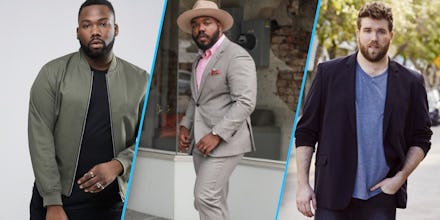What really constitutes a plus-size male model? The answer, it turns out, is far from clear.

Online retailer ASOS recently made history by being the first online store aimed at young people with its very own plus-size division for men.
Online, you can find dress shirts and bomber jackets and T-shirts all up to a size XXXXL. For plus-size men, it's a major step towards fashion recognizing them as consumers.
Still though, a question remains looming over plus-size male modeling: What constitutes and really defines a plus-size male model?
It's a question that was answered for plus-size female models early on. Plus-size clothing starts at a size 12 or 14, so those models did for the most part, too. But while plus-size female models and women's clothes remain boxed in by this size minimum, plus-size male models (and plus-size clothing targeted at men) don't have a standardized size minimum — or really any definition at all.
As a result, it's up to the clothing companies and modeling agencies to figure that out on their own, and as we quickly learned through various interviews, a number that remains elusive in its exactness.
Over at ASOS, the sizes for the plus-size men's section goes up to 4XL with it's pants sizes beginning at a 44-inch waist, so that means men who are that size or over are definitely plus-size. Over at the plus-size brand MVP Collections, clothing comes in sizes up to 6XL and jeans come in sizes 38 to 50. Over at the big and tall brand Oublier, shirts and pants go up to a 5XL.
And according to Oublier's founder, Jamaal Carroll, the dimensions of plus-size male models could totally vary.
"I think a plus-size male model at the very least is a 38 to 40-inch waist," Carroll said in a previous interview. "The height can vary. You can be 5'5" with a 30-inch waist and be a big guy. If it’s a slimmer fitting brand, it’s not going to fit the traditional 38-40 inch guy. I like to have my models to be at least a 42/44 even. 2X or 3X tops. You have good looking big guys in all shapes. It just depends."
As it turns out, setting the minimum size, the plus-size male equivalent to the plus-size female's size 12, is much harder than anticipated.
While Carroll thought it was more like a 38 to 40-inch waist that'd constitute a plus-size guy, Spencer Salley, a senior agent at New York Models, thinks the minimum is just a bit bigger than that.
"Well, the normal size is 38 to 40 suit size, so it would probably be anything over that," Salley told Mic in a previous interview. "I think you'd have to be substantially over that to be qualified as plus."
Even men who consider themselves plus-size male models feel lost about this one.
Model Kelvin Davis, who's modeled for Chubbies and Aerie and runs a body-positive Instagram and blog, thinks plus-size male models should be larger than typical male models today.
"Apparently the standard for a male model is like a 32/32 or a 32/34," Davis said in a previous interview. "So I think anyone over a size 34 or 36 is considered a plus size or anyone over that standard would be considered a plus-size male model."
But even that seems like the wrong answer given that the one plus-size male model signed to IMG's Brawn division, Zach Miko, has a 42" waist, and is 6'6". (Mic reached out to IMG and Miko about their own definitions for plus-size, or brawn, and did not hear back.)
Meanwhile over at Bridge Models, a plus agency over in the U.K., there are multiple men signed, all of whom have waists larger than just 33 inches, but yet again, the agency doesn't seem too concerned with the numbers.
"We are looking for healthy and attractive men that are photogenic and have the confidence and personality needed to become a model," Charlotte Griffiths, the co-owner of Bridge Models, said in an email.
So the general consensus, it seems, is that men with somewhere around a 34-inch waist or larger would be considered plus, but no one really knows who's making the rules just yet.
"A lot of me honestly thinks that a lot of agencies want to do it, but I learned at New York Fashion Week that the way the fashion industry works is that if the designer or brand doesn't have the sizing for it, there's no need for the models," Davis said in a previous interview. "So until brands and designers start saying that I want my brand and models to look like this, then things will change."
With ASOS, it seems things are slowly moving in the right direction. Still though, with the question "What is a plus-size male model?" without a clear consensus, it makes one think that the movement as a whole still has a lot of work to do, beyond just making sure larger guys have the kinds of clothes they deserve.